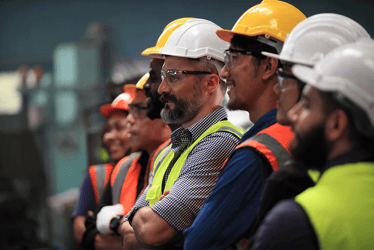The Packaging Industry's Sustainability Challenge: Why ERP Systems Are Essential for Success A straightforward guide to navigating sustainability regulations across folding carton, flexible...
CAPEX vs OPEX: How MES Can Bridge the Equipment Gap
Replacing machinery requires significant investment, while keeping outdated assets running can drive up operational costs.
Here we explore how packaging technology solutions can offer a smart solution to bridge the gap.
Contents
What is CAPEX?
Capital expenditures (CAPEX) refer to the funds a business invests in acquiring, upgrading, or maintaining physical assets such as machinery, equipment, and facilities.
In packaging manufacturing, CAPEX often includes purchasing new production lines, installing automation systems, or expanding plant infrastructure. These are typically high-cost, long-term investments aimed at increasing capacity, improving efficiency, or maintaining a competitive edge.
While CAPEX can drive strategic growth, it demands careful financial planning, as large upfront expenses may affect cash flow and profitability.
What is OPEX?
Operational expenditures (OPEX) are the ongoing costs required to keep a business running on a daily basis. In packaging manufacturing, OPEX includes expenses like maintenance, labor, utilities, raw materials, and increasingly, software subscriptions, including MES applications delivered under term licensing models.
Unlike CAPEX, which involves one-time investments, OPEX covers recurring costs that directly influence operational efficiency and profitability.
Modern MES applications - when offered as subscription-based or term-licensed solutions - fall into OPEX rather than CAPEX. This allows manufacturers to adopt advanced production management tools without the burden of large upfront capital investments. Instead, they pay predictable, scalable fees as part of their operational budget.
Managing OPEX effectively is essential: optimizing energy use, reducing downtime, and leveraging data from MES tools can all lead to improved margins, enhanced agility, and long-term sustainability.
The Equipment Dilemma: Maintain, Upgrade, or Replace?
Making the right investment decisions affects cash flow, profitability, and long-term sustainability.
Many manufacturers and converters continue to use older equipment. While functional, these machines may not operate as efficiently as newer models. Replacing them requires significant investment, which can be difficult to justify. However, keeping outdated machinery in production can lead to rising operational costs. Downtime, higher energy consumption, and frequent maintenance increase OPEX over time.
Instead of a complete machine replacement, software can help manufacturers optimize existing equipment, reducing operational costs while extending asset life.
Optimizing Older Equipment with Software
Advancements in packaging software enable manufacturers to improve performance without significant capital investments. Some key benefits include:
- Predictive Maintenance: AI-driven analytics identify early signs of mechanical failure, allowing maintenance teams to act before breakdowns occur. This reduces downtime and avoids expensive emergency repairs.
- Process Optimization: MES Applications can augment existing technology stacks, and provide packaging specific solutions, like real-time production data, providing insights that help improve throughput, reduce waste, and adjust machine settings dynamically.
- Energy Management: Monitoring and automation tools can optimize energy consumption, lower costs, and reduce environmental impact.
Upgrading equipment with the right software allows manufacturers to maintain productivity while controlling OPEX. The need for expensive new machinery is delayed, and existing assets continue to deliver value.
Industry Trends: Shifting CAPEX to OPEX Models
The rise of software-based solutions aligns with industry trends focusing on reducing upfront capital investments. Some of these include:
- Equipment-as-a-Service (EaaS): Instead of outright purchases, manufacturers can lease equipment under service agreements that bundle maintenance and software updates into a single cost structure.
This approach shifts expenses from CAPEX to OPEX, preserving cash flow. According to Clayton & McKervey, leasing can be an attractive option when equipment technology changes quickly or businesses need financial flexibility. - Outcome-Based Service Agreements: Instead of paying for equipment or software outright, manufacturers can opt for performance-based contracts. Vendors provide solutions that guarantee improvements in efficiency, waste reduction, or uptime, aligning costs with measurable outcomes.
A recent Roland Berger report highlights how manufacturers are moving toward service-based agreements to reduce capital investments and share risk with technology providers.
Financial Considerations: OPEX Reduction and ROI
Integrating software with existing equipment offers direct financial benefits.
- Lower Operating Costs: Reducing energy consumption, optimizing maintenance, and minimizing waste directly contribute to lower OPEX.
- Improved Profit Margins: Increased efficiency means lower production costs per unit. The packaging and container industry currently operates with an average gross profit margin of 21.71% and a net profit margin of 2.85%. Software-driven improvements can help businesses outperform these benchmarks.
- Market Growth Potential: The global packaging machinery market is projected to grow from USD 50.08 billion in 2024 to approximately USD 78.75 billion by 2034. Companies investing in optimization now will be better positioned for future market demands.
OEMs Recognizing the Role of Software in Packaging Operations
Leading Original Equipment Manufacturers (OEMs) are shifting their focus toward software-driven solutions. This was highlighted at drupa 2024, where BOBST announced its move into software and digital integration for packaging production. The company emphasized that future efficiency gains would come from connected production lines, automation, and real-time data-driven decision-making rather than new hardware investments.
Jean-Pascal Bobst, CEO of Bobst Group, noted that software-driven solutions will empower packaging manufacturers to optimize their operations while moving towards more sustainable business practices.
This shift reflects a broader trend where packaging OEMs embed software into their ecosystems to enhance productivity, reduce waste, and improve production flexibility.
Making the Right Investment Decision
Choosing between CAPEX-heavy equipment upgrades and OPEX-focused software optimization is a strategic decision for packaging manufacturers. Software solutions provide an effective way to enhance efficiency, reduce costs, and extend the life of existing machinery. This approach allows businesses to remain agile and responsive to market demands while maintaining financial stability.
By focusing on software-driven improvements, manufacturers can maximize their current assets, lower operational expenses, and improve production performance without committing to significant capital investments. Optimizing existing resources can be a practical and financially sound strategy in an industry where margins are tight.
Let’s Talk About Your Optimization Strategy
Every packaging manufacturer and converter faces unique challenges when balancing CAPEX and OPEX. The right software solution can make all the difference in improving efficiency, reducing waste, and maximizing profitability.
Let's start a conversation if you’re exploring ways to modernize your existing equipment while keeping costs under control. Our team can help you identify the best approach to optimize your operations without unnecessary capital investments. Get in touch today to see how software can transform your production efficiency.





